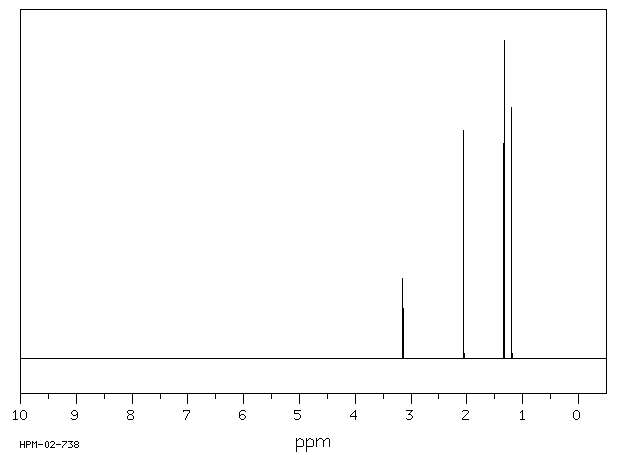3,4-环氧-4-甲基戊烷-2-酮 | 4478-63-1
中文名称
3,4-环氧-4-甲基戊烷-2-酮
中文别名
——
英文名称
3,4-epoxy-4-methyl-2-pentanone
英文别名
1-(3,3-dimethyloxiran-2-yl)ethan-1-one;4-methyl-3-penten-2-one oxide;3,4-epoxy-4-methylpentane-2-one;1-(3,3-dimethyl-oxiranyl)-ethanone;3-Acetyl-2,2-dimethyl-oxiran;3,4-epoxy-4-methylpentan-2-one;4-methyl-3,4-epoxy-2-pentanone;3,3-Dimethyl-2-acetyloxirane;1-(3,3-dimethyloxiran-2-yl)ethanone
CAS
4478-63-1
化学式
C6H10O2
mdl
——
分子量
114.144
InChiKey
NNQKVIBIXATSIX-UHFFFAOYSA-N
BEILSTEIN
——
EINECS
——
-
物化性质
-
计算性质
-
ADMET
-
安全信息
-
SDS
-
制备方法与用途
-
上下游信息
-
文献信息
-
表征谱图
-
同类化合物
-
相关功能分类
-
相关结构分类
物化性质
-
沸点:44-48 °C(Press: 15 Torr)
-
密度:0.9715 g/cm3
计算性质
-
辛醇/水分配系数(LogP):0.3
-
重原子数:8
-
可旋转键数:1
-
环数:1.0
-
sp3杂化的碳原子比例:0.83
-
拓扑面积:29.6
-
氢给体数:0
-
氢受体数:2
安全信息
-
海关编码:2914190090
SDS
上下游信息
反应信息
-
作为反应物:描述:3,4-环氧-4-甲基戊烷-2-酮 在 sodium hydroxide 、 thiourea dioxide 、 四丁基溴化铵 作用下, 以 四氢呋喃 为溶剂, 反应 0.2h, 以40%的产率得到4-甲基-3戊烯-2-酮参考文献:名称:将α,β-环氧酮方便地脱氧为烯酮摘要:在相转移条件下,使用氨基亚氨基甲烷亚磺酸(二氧化硫脲)作为还原剂,已开发出一种新的有效的方法将α,β-环氧酮脱氧成烯酮。均三甲苯氧化物,异佛尔酮,(-)-香芹酮,(+)-6-甲基-香芹酮,(+)-6-乙基-香芹酮和(-)-甲炔醛的环氧化物被良好地转化为各自的烯酮产量。DOI:10.1016/s0040-4039(96)02451-3
-
作为产物:描述:参考文献:名称:三烷基锡烷基甲基锂与α,β-环氧酮和α-氯酮的反应摘要:三烷基锡烷基甲基锂与α,β-环氧酮的反应主要产生环丙醇,而α-氯酮的生成烯丙醇和/或环丙醇的量取决于试剂与底物的摩尔比而变化。DOI:10.1016/s0040-4020(01)86394-8
文献信息
-
Oxygen transfer reactions from an Oxaziridinium tetrafluoroborate salt to Olefins作者:Xavier Lusinchi、Gilles HanquetDOI:10.1016/s0040-4020(97)00890-9日期:1997.10Oxaziridinium efficiently epoxidises olefins. It reacts as an electrophilic reagent and does not transfer its oxygen to deactivated double-bonds or carbonyl functions. Epoxidation of cyclic allylic acetates shows a remarkable diastereoselectivity leading to the syn isomer. We propose that the epoxidation reaction proceeds through a one-step process.恶嗪鎓有效地环氧化烯烃。它作为亲电子试剂反应,不会将其氧转移到失活的双键或羰基官能团上。环状烯丙基乙酸酯的环氧化显示出显着的非对映选择性,导致了顺式异构体。我们建议环氧化反应通过一个一步的过程进行。
-
Organic thiol metal-free stabilizers and plasticizers for halogen-containing polymers申请人:Starnes Herbert William公开号:US20050049307A1公开(公告)日:2005-03-03Organic thiol compounds based on pentaerythritol and dipentaerythritol are described herein. More specifically, the compounds of the present invention are mixed esters of pentaerythritol and dipentaerythritol having at least one sulfhydryl group and preferably a plurality of sulfhydryl groups as well as at least one non-thiol-containing group. The organic thiol compounds are utilized to plasticize and/or heat stabilize halogen-containing polymer compositions especially poly(vinyl chloride) compositions. The compositions are substantially free or free of metal-based stabilizers, Lewis acids and terpenes. The compounds of the present invention are ideally utilized in polymers normally susceptible to deterioration and color change which can occur during processing of the polymer or exposure of the polymer to certain environments and surprisingly also serve as excellent plasticizers.
-
Competitive Reactions of Diene Cation Radicals Formed on Irradiated Metal Oxide Surfaces作者:Marye Anne Fox、Debra D. Sackett、Janet N. YounathanDOI:10.1016/s0040-4020(01)90277-7日期:1987.1which involves the intermediacy of a diene cation radical generated by transfer of an electron from the adsorbed diene to a photogenerated hole localized at the surface of the excited TiO2 particle. Non-oxidative cleavage products are also observed, and the effect of the semiconductor surface in controlling reactivity of the photogenerated cation radical is discussed. The first examples of aromatization研究了悬浮在氧化CH 3 CN中的TiO 2粉末的长波长紫外线辐照引起的共轭二烯的非均相光化学氧化。在几乎所有情况下,都观察到由双键的氧化裂解产生的产物,与先前报道的单烯烃平行。提出了一种机制,该机制涉及通过将电子从吸附的二烯转移到位于激发的TiO 2表面上的光生空穴而产生的二烯阳离子自由基的中间体。粒子。还观察到非氧化裂解产物,并讨论了半导体表面在控制光生阳离子自由基反应性中的作用。提出了由辐射的半导体悬浮液介导的芳构化和Diels-Alder二聚化的第一个例子。
-
Metal-Free and Efficient Epoxidation of α,β-Unsaturated Ketones with 1,1,2,2-Tetrahydroperoxy-1,2-Diphenylethane as a Powerful Solid Oxidant作者:Kaveh Khosravi、Shirin Naserifar、Boshra MahmoudiDOI:10.1002/jccs.201700026日期:2017.61,1,2,2‐Tetrahydroperoxy‐1,2‐diphenylethane was used for the efficient and metal‐free epoxidation of various α,β‐unsaturated ketones, carried out under mild alkaline conditions at room temperature.
-
Microwave Promoted Epoxidation of α,β-Unsaturated Ketones in Aqueous Sodium Perborate作者:Ali Sharifi、Mohammad Bolourtchian、Farshid MohsenzadehDOI:10.1039/a803846e日期:——A series of α,β-unsaturated ketones has been treated with sodium perborate in water and 1,4-dioxane under microwave irradiation to produce α,β-epoxyketones in good yields.
表征谱图
-
氢谱1HNMR
-
质谱MS
-
碳谱13CNMR
-
红外IR
-
拉曼Raman
-
峰位数据
-
峰位匹配
-
表征信息
同类化合物
(反式)-4-壬烯醛
(s)-2,3-二羟基丙酸甲酯
([1-(甲氧基甲基)-1H-1,2,4-三唑-5-基](苯基)甲酮)
(Z)-4-辛烯醛
(S)-氨基甲酸酯β-D-O-葡糖醛酸
(S)-3-(((2,2-二氟-1-羟基-7-(甲基磺酰基)-2,3-二氢-1H-茚满-4-基)氧基)-5-氟苄腈
(R)-氨基甲酸酯β-D-O-葡糖醛酸
(5,5-二甲基-2-(哌啶-2-基)环己烷-1,3-二酮)
(2,5-二氟苯基)-4-哌啶基-甲酮
龙胆苦苷
龙胆二糖甲乙酮氰醇(P)
龙胆二糖丙酮氰醇(P)
龙胆三糖
龙涎酮
齐罗硅酮
齐留通beta-D-葡糖苷酸
鼠李糖
黑芥子苷单钾盐
黑海棉酸钠盐
黑木金合欢素
黑曲霉三糖
黑介子苷
黄尿酸8-O-葡糖苷
麻西那霉素II
麦迪霉素
麦芽糖脎
麦芽糖基海藻糖
麦芽糖1-磷酸酯
麦芽糖
麦芽四糖醇
麦芽四糖
麦芽十糖
麦芽六糖
麦芽五糖水合物
麦芽五糖
麦芽五糖
麦芽五糖
麦芽三糖醇
麦芽三糖
麦芽三糖
麦芽三塘水合
麦芽七糖水合物
麦芽七糖
麦法朵
麦可酚酸-酰基-Β-D-葡糖苷酸
麦利查咪
麝香酮
鹤草酚
鸢尾酚酮 3-C-beta-D-吡喃葡萄糖苷
鸡矢藤苷







